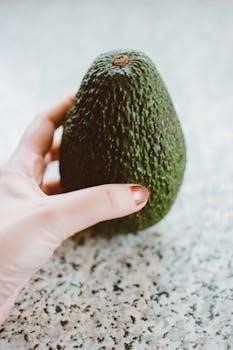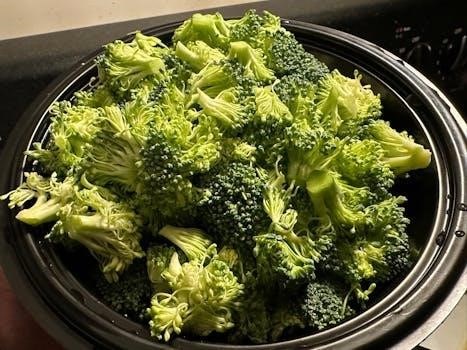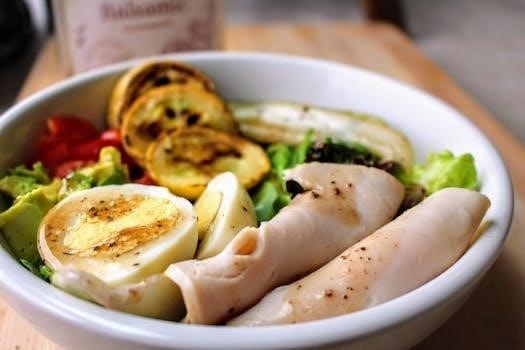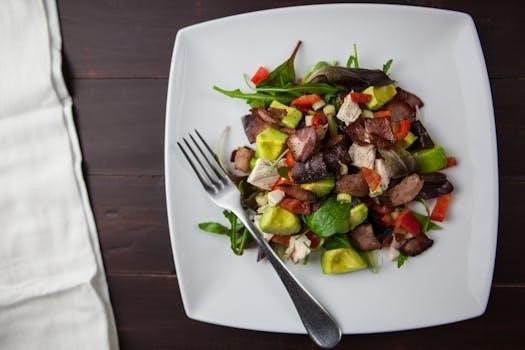paleo diet meal plan pdf
What is the Paleo Diet?
The Paleo diet, also known as the caveman diet, focuses on consuming foods that our ancestors ate. It emphasizes whole, unprocessed foods, promoting a return to simpler eating habits. It excludes grains, dairy, and legumes.
Core Principles of Paleo Eating
The core of Paleo eating revolves around mimicking the diet of our hunter-gatherer ancestors. This means prioritizing whole, unprocessed foods. A key principle is to eliminate modern processed items, such as grains, legumes, and refined sugars. It encourages the consumption of lean proteins, healthy fats, vegetables, and fruits. The Paleo approach emphasizes nutrient-dense foods over calorie-dense processed options, aligning with how early humans naturally nourished themselves.
Foods Included in a Paleo Diet
A Paleo diet emphasizes whole, unprocessed foods. It includes lean meats, fish, vegetables, fruits, nuts, and seeds. These foods are considered to be what our ancestors consumed.
Allowed Food Groups
The Paleo diet encourages a wide variety of whole, unprocessed foods. This includes lean proteins like grass-fed beef and poultry, as well as fish and seafood. You can enjoy an abundance of fresh fruits and vegetables, along with healthy fats from nuts, seeds, and oils like avocado and olive oil. Eggs are also a great source of protein and nutrients. Herbs and spices are welcome additions to add flavor.
Foods to Avoid
The Paleo diet restricts several food groups that were not available to our Paleolithic ancestors. This means avoiding grains such as wheat, rice, and oats, as well as legumes like beans and lentils. Dairy products are also excluded, including milk, cheese, and yogurt. Processed foods, refined sugars, and unhealthy oils should be eliminated entirely. These restrictions are key to following the Paleo diet.
Sample Paleo Meal Plan Structures
Paleo meal plans can be structured in various ways, often including 7-day and 14-day examples. These plans typically provide a framework for daily meals and snacks, offering a variety of paleo-friendly options.
7-Day Meal Plan Example
A 7-day Paleo meal plan can serve as a starting point, offering a balanced approach to paleo eating. These plans often include varied meals using approved foods like eggs, meats, vegetables, and fruits. They often incorporate leftovers to save time and ensure a diverse nutrient intake throughout the week. Such plans may be found as a PDF for easy access.
14-Day Meal Plan Example
A 14-day Paleo meal plan expands upon the 7-day version, providing a more comprehensive look at adhering to the diet. These plans often include printable grocery lists for convenience. Such meal plans offer a deeper understanding of paleo meal diversity, showcasing how to enjoy a wide variety of meals over an extended period, which are often available as PDFs for easy use.

Paleo Meal Preparation Strategies
Efficient paleo meal preparation involves planning and prepping ingredients. This includes chopping vegetables, portioning meats, and utilizing leftovers for quick meals. This is key for adhering to the plan.
Meal Prepping Tips
To streamline paleo meal prepping, start by chopping onions and peppers for easy additions to dishes. Separate meat portions into bags and prepare lunches from leftovers the night before. These actions save time during the week. Consider preparing components like cauliflower rice or roasted vegetables in advance. This ensures quick and healthy paleo meals are readily available. Meal prepping is an essential aspect of the paleo diet.
Grocery Shopping Lists
Crafting an effective paleo grocery list requires focusing on whole, unprocessed foods. Prioritize lean meats, fish, and seafood, along with a wide array of fresh vegetables and fruits. Include nuts, seeds, and healthy oils like olive and avocado oil. Exclude items such as grains, legumes, and dairy. A well-planned list ensures you have all the necessary paleo-compliant ingredients for your meal plans, making shopping efficient and effective for paleo diet success.
Benefits of Following a Paleo Diet
Adopting a Paleo diet can lead to several health improvements, including weight loss and reduced risk of certain health conditions. It encourages consumption of nutrient-dense, whole foods.
Potential Health Improvements
Following a Paleo diet may offer several potential health advantages. These include improved blood sugar control due to the elimination of processed foods and refined carbohydrates. Additionally, the diet’s focus on whole foods can lead to reduced inflammation and improved gut health. Many individuals also report increased energy levels and better overall well-being while adhering to this dietary approach.
Weight Loss Results
The Paleo diet is often associated with weight loss due to its emphasis on whole, unprocessed foods and the elimination of processed sugars and grains. Many individuals experience weight loss during the first few weeks of transitioning to a Paleo diet, which can include both water weight and fat loss. The high protein intake can also help to promote satiety and reduce overall calorie consumption, contributing to successful weight management.

Customizing Your Paleo Plan
Adapting the Paleo diet to your needs is crucial for long-term success. This involves adjusting portion sizes to meet individual calorie requirements and personalizing meal choices based on preferences.
Adjusting Portions Based on Calorie Needs
When following a Paleo diet, it is important to adjust your meal portions to match your individual calorie requirements. For example, if a meal plan provides 1400 calories per day, but you require 1800 calories, you should increase portion sizes by a factor of 1.28. This ensures you meet your energy needs while staying within the Paleo guidelines. It’s essential to understand your body’s specific needs.
Personalizing for Individual Preferences
The Paleo diet allows for personalization to fit your unique tastes and dietary preferences. While adhering to core principles, you can choose from a variety of allowed foods, focusing on what you enjoy most. This flexibility helps maintain long-term adherence to the diet. For example, if you prefer certain vegetables or meats, incorporate those more frequently into your meal plans. Customization is key to sustainability.
Paleo Diet and Detox
Transitioning to Paleo can initiate a detox period as your body adjusts. Expect changes, like increased bathroom trips, as your system flushes out toxins. Cravings might be challenging, but they are temporary.
Initial Body Reactions
When starting the Paleo diet, some individuals may experience initial body reactions as their system adapts to the dietary changes. These reactions might include increased urination due to the body flushing out excess fluids and toxins. Additionally, some people might notice temporary shifts in digestion as their body adjusts to higher fat and protein intake and lower carbohydrate consumption. These are typically normal adjustments.
Managing Cravings
Managing cravings is a crucial aspect of sticking to the Paleo diet. Initially, cravings for processed foods, sugars, and grains can be intense. Strategies for managing these cravings include ensuring adequate protein and healthy fat intake at each meal to promote satiety. Furthermore, having Paleo-friendly snacks readily available and staying hydrated can also help in curbing urges and preventing diet derailment.

Paleo Recipes and Meal Ideas
The Paleo diet offers a wide array of delicious meal options. These options include recipes that incorporate fresh vegetables, lean proteins, and healthy fats. There are many resources for ideas.
Breakfast Options
Paleo breakfasts often feature eggs cooked in healthy oils, combined with vegetables like spinach or bell peppers. Another common choice is a piece of fruit. Consider adding some healthy fats, such as avocado, to your meal. Some will also incorporate nuts and seeds into their morning routine. These provide protein and fiber, which will help with satiety.
Lunch and Dinner Ideas
For lunch, consider options like chicken salad made with olive oil, accompanied by a handful of nuts. Dinner might include burgers without the bun, served with vegetables and salsa. Another idea is garlic shrimp with cilantro spaghetti squash. Leftovers from dinner make a great lunch for the next day. Focus on lean proteins, vegetables, and healthy fats.

Paleo Diet Resources
Many resources are available for Paleo enthusiasts, including blogs, books, and websites with recipes. These provide guidance and support for meal planning and following the diet effectively.
Where to Find Recipes
Numerous online platforms offer a wealth of Paleo-friendly recipes. Websites, blogs, and social media groups dedicated to Paleo eating are excellent sources. Many recipe books focusing on the diet can also provide diverse meal ideas. Look for resources with printable meal plans, making it easier to organize your Paleo cooking. These resources offer varied and inspiring meal options.
Paleo Blogs and Books
Numerous Paleo blogs offer a wide variety of recipes, meal plans, and tips for beginners. These blogs often share personal experiences and provide motivational support. Additionally, many books are available that detail the science behind the Paleo diet and feature comprehensive recipe collections. Both blogs and books are invaluable resources, offering guidance and inspiration for your Paleo journey, providing support and varied ideas.
Transitioning to Paleo
Transitioning to a Paleo diet can be simplified with a structured plan. A 30-day meal plan can be very helpful, offering diverse meals and easing the change, making the dietary shift manageable.
Simplifying the Process
To simplify transitioning to the Paleo diet, start by focusing on whole, unprocessed foods. Gradually eliminate processed items, grains, and dairy from your current diet. Meal prepping is also key; prepare ingredients and meals in advance to save time and ensure you stick to the plan. Use a 30-day meal plan for guidance, which will help introduce a variety of flavors and nutrients, making the process easier and more enjoyable.
30-Day Meal Plan Support
A 30-day Paleo meal plan offers structured guidance for those new to the diet, simplifying the transition by providing a clear path to follow. These plans often include a variety of recipes for breakfast, lunch, and dinner. This support system helps introduce different flavors and ensures you are getting a balance of nutrients. They are designed to make the paleo diet less overwhelming and more achievable.
Paleo Diet and Meal Planning
Meal planning is crucial for success on the Paleo diet due to its restrictions. It helps ensure you have compliant foods readily available. Effective planning reduces the chance of unhealthy choices.
Importance of Planning
Planning is essential for a successful Paleo diet because it helps navigate the limitations of the diet effectively. With careful meal planning, you can ensure a diverse intake of nutrients and also avoid falling into unhealthy or non-Paleo eating habits; A well-structured plan makes grocery shopping more efficient, reduces impulsive choices, and saves time on meal preparation.
Tools for Meal Planning
Several tools can assist with Paleo meal planning, including printable meal plan templates, which provide a structured approach. Digital apps and websites offer customizable meal plans, recipes, and grocery lists. Food storage containers help keep prepped meals fresh, while using a weekly calendar helps in organizing meal schedules. These tools can simplify and streamline the planning process.
Paleo Diet and Meal Timing
Meal timing on the Paleo diet can be flexible, but balanced meals are key. Sample times might include breakfast, lunch, and dinner, with snacks as needed. Focus on nutrient-dense options.
Sample Meal Times
A typical Paleo meal schedule might begin with breakfast around 8⁚00 AM, followed by lunch between 12⁚00 PM and 1⁚00 PM. Dinner could be scheduled for 6⁚00 PM to 7⁚00 PM. These are guidelines and can be adjusted based on individual schedules and hunger levels. Consider incorporating snacks as needed between meals to maintain energy and avoid overeating at main meals. Remember to listen to your body’s cues.
Balanced Meal Examples
A balanced Paleo breakfast could include eggs with vegetables cooked in olive oil, alongside a piece of fruit. Lunch might feature a chicken salad made with olive oil, accompanied by a handful of nuts. Dinner could consist of a lean protein source, like burgers without the bun, paired with vegetables and salsa. These examples showcase the core principles of Paleo, emphasizing protein, healthy fats, and nutrient-rich produce.


